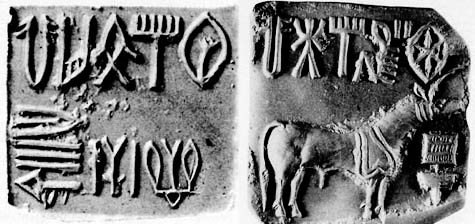 [Image: Two examples of Indus script, from The Hindu].
[Image: Two examples of Indus script, from The Hindu].
Wired Science today reports that Artificially Intelligent computers have at least partially cracked an otherwise unreadable, 4,000-year old language from the Indus Valley – which has at least me wondering if we haven’t already entered into the world of Philip K. Dick: our archaeologists are actually software programs bringing dead languages back to life.
But something about the story also reminds me of Nina Burleigh’s book Mirage, which I posted about last month, in which we read about Napoleon’s invasion of Egypt.
Accompanying Napoleon’s expeditionary force was a kind of secondary army of “savants”: scientists, researchers, archaeologists, linguists, and other scholars who were there, ostensibly, to produce a scientific record of Nile civilization, but who, conveniently for Napoleon, also “offered moral cover for the invasion.”
From Burleigh’s introduction:
When they first got to Egypt, the scientists tried to approach the land, people, animals, and relics not as tourists or literary travelers, or even colonizers, but from within their fields of scholarship. They categorized, measured, and collected, kept journals, and wrote reports that they read to one another at formal meetings in a recently vacated harem room. Set down and then abandoned in what was mostly a vast, uncharted desert, atheists surrounded by devout practitioners of a barely understood religion, encountering ruins that mutely testified to another equally unknown culture, they did not trust sense perception alone. They looked at and tried to explain what they saw by mathematically defining and classifying it.
To make a long story short, Napoleon’s scientists produced a massive and heavily illustrated catalog of Egyptian culture – you can actually buy an abridged version of it from Taschen – focusing on Pharaonic monuments and sand-covered ruins. However, the invasion also led to the discovery of the Rosetta Stone – and thus to the translation of ancient hieroglyphs.
In any case, what would the 21st-century equivalent of these savants be?
How interesting, I’d suggest, to imagine an army of Artificially Intelligent, wireless translation drones sent into the ruins of ancient temple complexes; they descend through otherwise inaccessible partly collapsed passages and domed vaults beneath hillsides in order to interpret the walls around them, narrating for the first time a vast and unfolding dream of gods and ancient earthquakes, their LEDs reflecting in colored glass mosaics on the floor.
Maybe they’d even use Twitter.
Think of it as WALL-E meets Champollion: a lonely machine installed somewhere in the darkness beneath the ruins of ancient India, hanging out with itself and telling myths of the birth of the universe, its feed syndicated live on blogs around the world.
what a great post
To make a long story short, Napoleon's scientists produced a massive and heavily illustrated catalog of Egyptian culture … focusing on Pharaonic monuments and sand-covered ruins. However, the invasion also led to the discovery of the Rosetta Stone …
Give the Description its due, though – its publication kicked off the Egyptian Revival, and its influence is still visible. Here's one particularly cool example – a library table that the Providence Atheneum had built ca. 1840 to house their folio copy:
http://www.flickr.com/photos/rock_creek/2667687222/